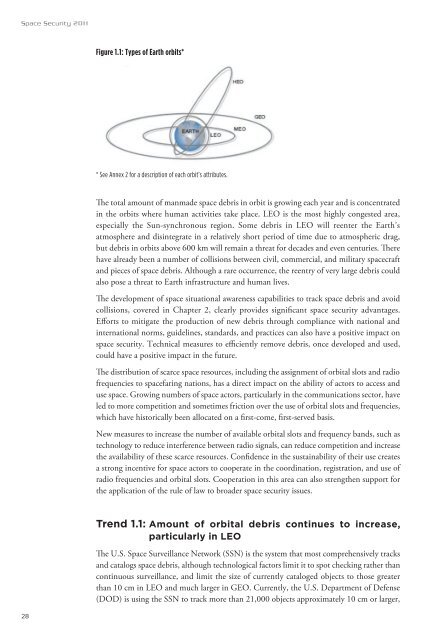Space Security Index
Space Security Index
Space Security Index
Create successful ePaper yourself
Turn your PDF publications into a flip-book with our unique Google optimized e-Paper software.
<strong>Space</strong> <strong>Security</strong> 2011<br />
28<br />
Figure 1.1: Types of Earth orbits*<br />
* See Annex 2 for a description of each orbit’s attributes.<br />
e total amount of manmade space debris in orbit is growing each year and is concentrated<br />
in the orbits where human activities take place. LEO is the most highly congested area,<br />
especially the Sun-synchronous region. Some debris in LEO will reenter the Earth’s<br />
atmosphere and disintegrate in a relatively short period of time due to atmospheric drag,<br />
but debris in orbits above 600 km will remain a threat for decades and even centuries. ere<br />
have already been a number of collisions between civil, commercial, and military spacecraft<br />
and pieces of space debris. Although a rare occurrence, the reentry of very large debris could<br />
also pose a threat to Earth infrastructure and human lives.<br />
e development of space situational awareness capabilities to track space debris and avoid<br />
collisions, covered in Chapter 2, clearly provides signicant space security advantages.<br />
Eorts to mitigate the production of new debris through compliance with national and<br />
international norms, guidelines, standards, and practices can also have a positive impact on<br />
space security. Technical measures to eciently remove debris, once developed and used,<br />
could have a positive impact in the future.<br />
e distribution of scarce space resources, including the assignment of orbital slots and radio<br />
frequencies to spacefaring nations, has a direct impact on the ability of actors to access and<br />
use space. Growing numbers of space actors, particularly in the communications sector, have<br />
led to more competition and sometimes friction over the use of orbital slots and frequencies,<br />
which have historically been allocated on a rst-come, rst-served basis.<br />
New measures to increase the number of available orbital slots and frequency bands, such as<br />
technology to reduce interference between radio signals, can reduce competition and increase<br />
the availability of these scarce resources. Condence in the sustainability of their use creates<br />
a strong incentive for space actors to cooperate in the coordination, registration, and use of<br />
radio frequencies and orbital slots. Cooperation in this area can also strengthen support for<br />
the application of the rule of law to broader space security issues.<br />
Trend 1.1: Amount of orbital debris continues to increase,<br />
particularly in LEO<br />
e U.S. <strong>Space</strong> Surveillance Network (SSN) is the system that most comprehensively tracks<br />
and catalogs space debris, although technological factors limit it to spot checking rather than<br />
continuous surveillance, and limit the size of currently cataloged objects to those greater<br />
than 10 cm in LEO and much larger in GEO. Currently, the U.S. Department of Defense<br />
(DOD) is using the SSN to track more than 21,000 objects approximately 10 cm or larger,

















